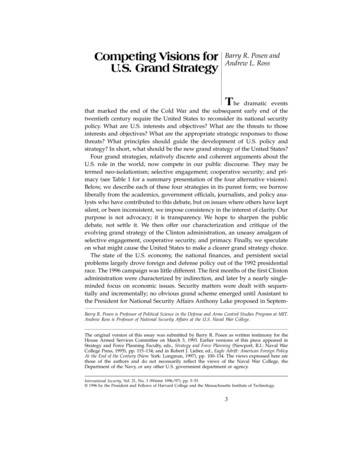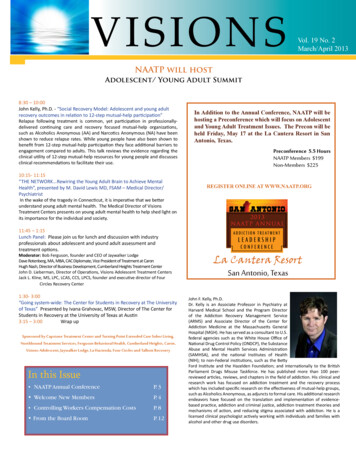
Transcription
Competing Visions forU.S. Grand StrategyBarry R. Posen andAndrew L. RossThe dramatic eventsthat marked the end of the Cold War and the subsequent early end of thetwentieth century require the United States to reconsider its national securitypolicy. What are U.S. interests and objectives? What are the threats to thoseinterests and objectives? What are the appropriate strategic responses to thosethreats? What principles should guide the development of U.S. policy andstrategy? In short, what should be the new grand strategy of the United States?Four grand strategies, relatively discrete and coherent arguments about theU.S. role in the world, now compete in our public discourse. They may betermed neo-isolationism; selective engagement; cooperative security; and primacy (see Table 1 for a summary presentation of the four alternative visions).Below, we describe each of these four strategies in its purest form; we borrowliberally from the academics, government ofªcials, journalists, and policy analysts who have contributed to this debate, but on issues where others have keptsilent, or been inconsistent, we impose consistency in the interest of clarity. Ourpurpose is not advocacy; it is transparency. We hope to sharpen the publicdebate, not settle it. We then offer our characterization and critique of theevolving grand strategy of the Clinton administration, an uneasy amalgam ofselective engagement, cooperative security, and primacy. Finally, we speculateon what might cause the United States to make a clearer grand strategy choice.The state of the U.S. economy, the national ªnances, and persistent socialproblems largely drove foreign and defense policy out of the 1992 presidentialrace. The 1996 campaign was little different. The ªrst months of the ªrst Clintonadministration were characterized by indirection, and later by a nearly singleminded focus on economic issues. Security matters were dealt with sequentially and incrementally; no obvious grand scheme emerged until Assistant tothe President for National Security Affairs Anthony Lake proposed in SeptemBarry R. Posen is Professor of Political Science in the Defense and Arms Control Studies Program at MIT.Andrew Ross is Professor of National Security Affairs at the U.S. Naval War College.The original version of this essay was submitted by Barry R. Posen as written testimony for theHouse Armed Services Committee on March 3, 1993. Earlier versions of this piece appeared inStrategy and Force Planning Faculty, eds., Strategy and Force Planning (Newport, R.I.: Naval WarCollege Press, 1995), pp. 115–134; and in Robert J. Lieber, ed., Eagle Adrift: American Foreign PolicyAt the End of the Century (New York: Longman, 1997), pp. 100–134. The views expressed here arethose of the authors and do not necessarily reºect the views of the Naval War College, theDepartment of the Navy, or any other U.S. government department or agency.International Security, Vol. 21, No. 3 (Winter 1996/97), pp. 5–53 1996 by the President and Fellows of Harvard College and the Massachusetts Institute of Technology.3
America’s Strategic Choices, Revised Edition 4
Competing Visions for U.S. Grand Strategy 5ber 1993 that U.S. policy shift “From Containment to Enlargement.” Not untilJuly 1994 were the ideas initially advanced by Lake codiªed in the administration’s National Security Strategy of Engagement and Enlargement. Those ideasremain intact in the February 1996 version of that White House document.1 Yetthe Clinton administration, like the Bush administration before it, has failed tobuild a domestic political consensus in support of its strategic vision. Thus thepost–Cold War grand strategy debate continues.We distinguish the four alternative strategies in four ways. We ask, ªrst, whatare the major purposes or objectives each identiªes for the United States ininternational politics? These range from a narrow commitment to the basicsafety of the United States to an ambitious effort to secure permanent U.S.global preeminence.Second, we ask: what are each strategy’s basic premises about internationalpolitics? Though advocates are seldom explicit, underlying disagreementsamong the strategies on basic questions help to explain their other disagreements. In particular, the four strategies disagree on the “fragility” of international politics—the propensity for developments unfavorable to the UnitedStates to cascade rapidly in ever more unfavorable directions, and for developments favorable to the United States to move in ever more favorable directions. A fragile international political system both requires and responds to U.S.activism. Answers to three central questions of modern international relationstheory affect each strategy’s assessment of the fragility of international politics:(1) Do states tend to balance against, or bandwagon with, expansionists? Thatis, will most states, faced with a neighbor growing in power and ambition, takesteps to improve their power through some combination of internal militarypreparation and external alignment? (2) Do nuclear weapons make conquesteasier or harder? If secure retaliatory nuclear deterrent forces are easy to get,and the risks they impose for ambitious aggressors are easy for those aggressors to grasp, then they make it difªcult for aspiring hegemons to improvetheir power position through intimidation or conquest. If, on the other hand,they cause hegemons to perceive themselves as invulnerable to attack, suchstates may be emboldened to act aggressively. (3) How much potentialinºuence does the United States actually have in international politics? Howdo we measure relative power in international politics; is it reasonable to speakof a unipolar world? Here, there are two subsidiary issues. Measured globally,1. Anthony Lake, “From Containment to Enlargement,” U.S. Department of State Dispatch, Vol. 4,No. 39 (September 27, 1993), pp. 658–664; A National Security Strategy of Engagement and Enlargement(Washington, D.C.: U.S. Government Printing Ofªce [U.S. GPO], July 1994); and A National SecurityStrategy of Engagement and Enlargement (Washington, D.C.: U.S. GPO, February 1996).
America’s Strategic Choices, Revised Edition 6how much international political inºuence can the current U.S. “share” of grossworld power resources—economic, technological, and military capabilities—buy? How much money, and how many lives, are the American people willingto pay for inºuence in international politics in the absence of a major threat?If the United States is relatively quite powerful in international politics, then itcan think in terms of great objectives. If not, its objectives will need to belimited. If the United States is inherently much more powerful than is oftenbelieved, then the American people may not need to sacriªce much more thanthey already do for the United States to undertake ambitious policies successfully.2We ask, third, what are the preferred political and military instruments ofeach strategy? Do advocates prefer to work multilaterally or unilaterally? Dothey favor international organizations or prefer traditional alliances? Howmuch military force does the United States require, and what kind? Our forcestructure analysis is indicative rather than comprehensive; as a heuristic devicewe rely substantially on the array of alternative force structures developed bythe late Les Aspin during his tenure as Chairman of the House Armed ServicesCommittee and then as Secretary of Defense early in the Clinton administration.3 The force structures (see Table 2) were developed with an eye to thenumber and variety of contingencies they could support—the “business end”of grand strategy.42. Each grand strategy should have an economic component. Most of the literature, however, treatsthe economic component in a cursory way, if at all. As we began to consider the possible economicelements of each alternative we determined that a separate essay would be required to offer morethan a superªcial treatment. Therefore, this essay conªnes itself to the political and military aspectsof alternative U.S. grand strategies.3. We also rely on these options because they have the unusual attribute that ªve of them largelyemploy the same basic methodology to develop force structure and to estimate the costs of thoseforce structures. Representative Les Aspin, “An Approach to Sizing American Conventional Forcesfor the Post-Soviet Era,” February 25, 1992 (unpublished manuscript); Secretary of Defense LesAspin, Report on the Bottom-Up Review (Washington, D.C.: Department of Defense, 1993); Congressional Budget Ofªce (CBO), Staff Memorandum, “Fiscal Implications of the Administration’sProposed Base Force,” December 1991 (unpublished manuscript); see also Andrew F. Krepinevitch,The Bottom-Up Review: An Assessment (Washington, D.C.: Defense Budget Project, 1994); and DovS. Zakheim and Jeffrey M. Ranney, “Matching Defense Strategies to Resources: Challenges for theClinton Administration,” International Security, Vol. 18, No. 1 (Summer 1993), pp. 51–78. TheBush-Cheney-Powell “Base Force” was probably generated by a somewhat different methodology.The individuals who made the budget estimates in every case had access to the best available costinformation. Other analysts have developed force structures and estimated costs on the basis oftheir individual methodologies; we chose not to employ them because we could not be sure theywere strictly comparable.4. However, there are reasons why the cost estimates in Table 2 could be too high or too low. Mostestimates, particularly those for the Base Force and Clinton Bottom-Up Review (BUR) force,
Competing Visions for U.S. Grand Strategy 7Fourth, to illustrate the real world implications of each grand strategy, weask: what are their positions on a number of basic issues now on the U.S.agenda, including nuclear proliferation, NATO enlargement, and regionalconºict?After describing each strategy along these four dimensions, we offer a shortcritique, which reºects both our own speciªc concerns and what we believeare the most credible counter-arguments that the proponents of the otherstrategies might offer.The essay closes with a brief review and analysis of the Clinton administration’s grand strategy, which consists of a core of cooperative security principlesand impulses, drawn toward primacy as it has faced a less tractable international environment than it expected, but constrained toward selectivity by aU.S. citizenry whose support for ambitious foreign projects seems shallow atbest. We explain why this compromise has proven necessary, and offer somehypotheses about what could cause this grand strategy to change.Neo-IsolationismNeo-isolationism is the least ambitious, and, at least among foreign policyprofessionals, probably the least popular grand strategy option.5 The newisolationists have embraced a constricted view of U.S. national interests thatrenders internationalism not only unnecessary but counterproductive. Nationalprobably underestimate the cost of major procurement after the turn of the century. On the otherhand, many estimates of the costs of smaller forces probably do not take credit for the savings thatought to accrue from proportional reductions in defense infrastructure that ought to accompanyreductions in force structure. This tends to occur for two reasons. First, because U.S. defense politicsfocuses on the Future Years Defense Plan, or FYDP, most policy-oriented budget analysts focusprimarily on the near-term budgetary consequences that would directly arise from incrementalreductions in existing forces. Second, infrastructure, particularly bases and depots, are oftenpolitically protected. It is only slightly absurd to suggest, therefore, that nearly all the conventionalcombat power in the U.S. military could be eliminated, and still leave us with a defense budgetof 100 billion a year, which is the implication of the trend of costs versus force structure in OptionsA–D.5. The new isolationists seldom refer to themselves as isolationists. Indeed, they often vociferouslydeny isolationist tendencies. Earl Ravenal, “The Case for Adjustment,” Foreign Policy, No. 81(Winter 1990–91), pp. 3–19, prefers “disengagement.” Patrick J. Buchanan, too, in “America First—and Second, and Third,” National Interest, No. 19 (Spring 1990), pp. 77–82, uses “disengagement.”Doug Bandow, “Keeping the Troops and the Money at Home,” Current History, Vol. 93, No. 579(January 1994), pp. 8–13, prefers “benign detachment.” Eric A. Nordlinger, however, in the mostsophisticated, and perhaps least conventional version of the new isolationism, Isolationism Reconªgured: American Foreign Policy for a New Century (Princeton, N.J.: Princeton University Press,1995), embraces “isolationism.”
America’s Strategic Choices, Revised Edition 8
Competing Visions for U.S. Grand Strategy 9
America’s Strategic Choices, Revised Edition 10defense—the protection of “the security, liberty, and property of the Americanpeople”6—is the only vital U.S. interest.The new isolationism subscribes to a fundamentally realist view of international politics and thus focuses on power.7 Its advocates ask: who has thepower to threaten the sovereignty of the United States, its territorial integrity,or its safety? They answer that nobody does.8 The collapse of the Soviet Unionhas left a rough balance of power in Eurasia. If either Russia or China beginsto build up its military power, there are plenty of wealthy and capable statesat either end of Eurasia to contain them. Indeed, Russia and China help tocontain one another. Thus no state has the capability to conquer the rest andso agglomerate enough economic capability and military mobilization potential to threaten the American way of life. Like traditional isolationism, thisstrategy observes that the oceans make such a threat improbable in any event.The United States controls about one quarter of the gross world product, twiceas much as its nearest competitor, Japan, and while not totally self-sufªcient,is better placed than most to “go it alone.” U.S. neighbors to the north andsouth are militarily weak and destined to stay that way for quite some time.The United States is inherently a very secure country.9 Indeed, the United Statescan be said to be strategically immune.10The new isolationism is strongly motivated by a particular understanding ofnuclear weapons. It concedes that nuclear weapons have increased the poten-6. Bandow, “Keeping the Troops and the Money at Home,” p. 10.7. The version of realism that underlies the new isolationism is minimal. Its strategic imperativesare even more limited than those of the minimal realism outlined by Christopher Layne, “Less isMore: Minimal Realism in East Asia,” National Interest, No. 43 (Spring 1996), pp. 64–77. Laynedistinguishes between maximal and minimal realism. He views a balance of power approach(which we call “selective engagement”) as minimal realism. Layne links primacy with maximalrealism. For an earlier version of minimal realism and neo-isolationism, see Robert W. Tucker, ANew Isolationism: Threat or Promise? (New York: Universe Books, 1972). Nordlinger, IsolationismReconªgured, is the most signiªcant exception to the generalization that neo-isolationism is drivenby a realist interpretation of international politics. His eclectic approach to developing a nationalstrategy of isolationism and its concurrent foreign policy is, in the end, informed more by liberalismthan realism.8. Alan Tonelson, “Superpower Without a Sword,” Foreign Affairs, Vol. 72, No. 3 (Summer 1993),p. 179, observes that “few international conºicts will directly threaten the nation’s territorialintegrity, political independence or material welfare.”9. Christopher Layne, “The Unipolar Illusion: Why New Great Powers Will Rise,” InternationalSecurity, Vol. 17, No. 4 (Spring 1993), p. 48, makes this point. He uses it to support an argumentfor a grand strategy that he calls “strategic independence.” It bears some similarity to the selectiveengagement strategy outlined below, albeit a rather inactive version of it.10. Nordlinger, Isolationism Reconsidered, pp. 6 and 63–91.
Competing Visions for U.S. Grand Strategy 11tial capacity of others to threaten the safety of the United States. But nuclearweapons make it very hard, indeed nearly inconceivable, for any power to wina traditional military victory over the United States. Nuclear weapons assurethe political sovereignty and the territorial integrity of the United States. Thecollapse of the Soviet Union has so reduced the military resources available toits successor states that a counterforce attack on U.S. nuclear forces, an old andexaggerated fear, is out of the question. There can be no politically rationalmotive for any country large or small to explode a nuclear weapon on NorthAmerica. U.S. retaliation would be devastating. Moreover, the fact that Britain,France, the People’s Republic of China, and Russia have nuclear retaliatoryforces makes it quite likely that these powers will deter each other, furtherreducing the risk that an ambitious hegemon could dominate and militarilyexploit the economic resources of the Eurasian landmass.issues and instrumentsGiven the absence of threats to the U.S. homeland, neo-isolationism holds thatnational defense will seldom justify intervention abroad. The United States isnot responsible for, and cannot afford the costs of, maintaining world order.The pursuit of economic well-being is best left to the private sector. Thepromotion of values such as democracy and human rights inspires ill-advisedcrusades that serve only to generate resentment against the United States;consequently, it is a poor guide to policy and strategy.The new isolationism would concede, however, that our great capabilitiesare a magnet for trouble so long as we are involved in any way in variouspolitical disputes around the world. Intervention in these disputes is thus agood way to attract attention to the United States. The strong try to deter theUnited States; the weak to seduce it; the dispossessed to blame it. Neo-isolationism would argue that those who fear terrorism, especially terrorism withnuclear, biological, or chemical weapons, can increase U.S. safety by keepingit out of foreign conºicts. Middle Eastern terrorists, for instance, whethersponsored by Syria, Iran, Iraq, or Libya, would ªnd little reason to target theUnited States and its citizens, either abroad or at home, if the United Statesrefrained from meddling in the Middle East.Neo-isolationism advises the United States to preserve its freedom of actionand strategic independence. Because neo-isolationism proposes that the UnitedStates stay out of political conºicts and wars abroad, it has no particular needfor political instruments. Even traditional alliance relationships that obligate
America’s Strategic Choices, Revised Edition 12the United States in advance, such as NATO, ought to be dismantled. International organizations are a place to talk, perhaps to coordinate internationalefforts to improve the overall global quality of life, but not to make or keeppeace. This would implicate the United States and draw it into conºicts.Most of the foreign policy issues now facing the United States would disappear under the new isolationism. The future of NATO, for instance, would beleft to Europe. Neo-isolationists would have the United States abandon thatanachronistic alliance, not lead the way in its ill-conceived expansion. Bosnia,too, is a European problem in which the United States has no concrete, materialstake. The United States would no longer be preoccupied with Russian politicaland economic reform, or the lack thereof. Arabs and Israelis would have to sortout their affairs (or not) without U.S. meddling. Islamists would be deprivedof the Great Satan. The North Korean threat would be left to South Korea, thecountry whose interests are actually threatened. In Latin America and Africa,the United States would no longer rescue Haitis and Somalias. Humanitarianassistance, if and when provided, would be conªned to disasters—famines,epidemics, earthquakes, and storms. The United States might be willing to helpclean up the mess after foreign wars have sorted themselves out. But intervention of any kind during wars would be viewed as a mistake, since at least oneside is likely to be disadvantaged by humanitarian assistance to the others andwould thus come to view the United States as an enemy.force structure. Neo-isolationism generates a rather small force structure.It is unlikely to cost more than two percent of GDP.11 First and foremost, theUnited States would need to retain a secure nuclear second-strike capability to11. Ravenal, “The Case for Adjustment,” pp. 15–19, develops a force structure and defense budgetwithin these parameters which is explicitly geared to support a grand strategy quite similar towhat we label isolationism. He suggests an active force of 1.1 million people, with six Army andtwo Marine divisions, eleven tactical air wings, six carriers with ªve air wings, and a strategicdyad of submarines and bombers, which could be funded for about 150 billion in constant 1991dollars, perhaps 175 billion in 1997 dollars, or roughly 2.5 percent of GDP. See Force A in Table 1,which is roughly the same size, but which then-Congressman Aspin estimated would cost considerably more, 231 billion in 1997 dollars, roughly 3 percent of GDP. See also Tonelson, “SuperpowerWithout a Sword,” pp. 179–180, who argues for a similar force structure, but who seems tosubscribe to a conservative version of selective engagement. The Center for Defense Informationhas proposed that an even smaller force structure would be sufªcient to support a strategy ofdisengagement. For 104 billion in constant 1993 dollars, CDI proposed to ªeld a force of only500,000 people, one Marine and three Army divisions, four Air Force tactical wings, two carriersand 221 other combat vessels, and a nuclear force of 16 submarines. See “Defending America: CDIOptions for Military Spending,” Defense Monitor, Vol. 21, No. 4 (1992). Nordlinger, IsolationismReconªgured, p. 46, suggested that forces at half the levels sustained during the Cold War and earlypost–Cold War years would be sufªcient.
Competing Visions for U.S. Grand Strategy 13deter nuclear attacks from any quarter. Modest air and missile defenses mightbe put in place to deal with low-grade threats. Second, the U.S. intelligencecommunity would have the task of watching worldwide developments ofweapons of mass destruction in order to forestall any terrorist threats againstthe United States. If such threats occurred, it would be their job to ªnd anaddress against which retaliation could be directed. Third, the United Stateswould probably wish to retain a capable navy (perhaps a third to a half thecurrent size), and diverse special operations forces. The purpose would largelybe to protect U.S. commerce abroad from criminal activity—piracy, kidnapping,and extortion. The remainder of U.S. forces would be structured to preserveskills at ground and tactical air warfare in the event that the balance of poweron the Eurasian land mass eroded, perhaps requiring a return to a more activistU.S. policy. Since the burden of defending wealthy allies can be discarded inthe aftermath of the Soviet Union’s fortuitous collapse, those forces need notbe forward-deployed in Europe and Asia. A major mission of the intelligencecommunity would be to provide timely warning of strategic developments inEurasia that would warrant a return to a more activist foreign and securitypolicy. The U.S. force structure would no longer be driven either by demandingand costly forward presence requirements or by the need to prepare to engagein multiple foreign contingencies. American military forces would be used onlyto defend narrowly construed U.S. interests. Given these limited requirements,even “Force A” (see Table 2), the smallest of Aspin’s notional force structures,is larger than necessary.critiqueThe United States can, more easily than most, go it alone. Yet we do not ªndthe arguments of the neo-isolationists compelling. Their strategy serves U.S.interests only if they are narrowly construed. First, though the neo-isolationistshave a strong case in their argument that the United States is currently quitesecure, disengagement is unlikely to make the United States more secure, andwould probably make it less secure. The disappearance of the United Statesfrom the world stage would likely precipitate a good deal of competitionabroad for security. Without a U.S. presence, aspiring regional hegemons wouldsee more opportunities. States formerly defended by the United States wouldhave to look to their own military power; local arms competitions are to beexpected. Proliferation of nuclear weapons would intensify if the U.S. nuclearguarantee were withdrawn. Some states would seek weapons of mass destruc-
America’s Strategic Choices, Revised Edition 14tion because they were simply unable to compete conventionally with theirneighbors. This new ºurry of competitive behavior would probably energizemany hypothesized immediate causes of war, including preemptive motives,preventive motives, economic motives, and the propensity for miscalculation.There would likely be more war. Weapons of mass destruction might be usedin some of these wars, with unpleasant effects even for those not directlyinvolved.Second, if these predictions about the international environment are correct,as competition intensiªed U.S. decision-makers would continuously have toreassess whether their original assumptions about the workings of the balanceof power in Eurasia and the deterrent power of nuclear weapons were stillvalid. Decision-makers require both good political intelligence and compellingcause-effect knowledge about international politics to determine that a policyshift is in order. More importantly, decision-makers would have to persuadethe country that a policy reversal is necessary, but U.S. foreign policy is a toughthing to change. Given these problems, how much trouble would have to occurbefore the United States returned to a more active role? Would the United Statesreturn in time to exert its inºuence to help prevent a great power war? If theUnited States did decide that a more active role was necessary, how muchinºuence would it have after years of inactivity? Would the United Statesreturn in time to prevent an aspiring hegemon from getting a jump ahead, asNazi Germany did in World War II? If not, the costs of containment or rollbackcould prove substantial.Third, though the United States would save a great deal of money in itsdefense budget, perhaps 1–1.5 percent of GDP, or 70–100 billion per yearrelative to the budgets planned by the Clinton administration, these annualsavings do not seem commensurate with the international inºuence the strategy would forgo. Though this is a lot of money, which has many worthyalternative uses, the redirection of these resources from the military is unlikelyto make the difference between a healthy and an unhealthy economy that isalready some seven trillion dollars in size. Neo-isolationists seem willing totrade away considerable international inºuence for a relatively modest improvement in domestic welfare. Given the potential stakes in internationalpolitics, the trade-off is imprudent. Engagement in international politics imposes obvious burdens and risks. Shedding an active role in internationalpolitics, however, increases the risks of unintended consequences and reducesU.S. inºuence over the management of those consequences, and over issuesthat we can hardly anticipate.
Competing Visions for U.S. Grand Strategy 15Selective EngagementSelective engagement endeavors to ensure peace among powers that havesubstantial industrial and military potential—the great powers.12 By virtue ofthe great military capabilities that would be brought into play, great powerconºicts are much more dangerous to the United States than conºicts elsewhere. Thus Russia, the wealthier states of the European Union, the People’sRepublic of China, and Japan matter most. The purpose of U.S. engagementshould be to affect directly the propensity of these powers to go to war withone another. These wars have the greatest chance of producing large-scaleresort to weapons of mass destruction, a global experiment that the UnitedStates ought to try to prevent. These are the areas of the world where the worldwars have originated, wars that have managed to reach out and draw in theUnited States in spite of its strong inclination to stay out.Like the new isolationism, selective engagement emerges from the realisttradition of international politics and its focus on large concentrations ofpower.13 Like cooperative security, it is also interested in peace. Though someof its proponents agree with the neo-isolationist premise that U.S. geographyand nuclear deterrence make the United States so secure that a Eurasianhegemon would not pose much of a security problem for the United States,14selective engagement holds that any great power war in Eurasia is a danger tothe United States.15 On the basis of both the increased destructive power ofmodern weaponry and the demonstrated inability of the United States to stay12. Robert Art, “A Defensible Defense: America’s Grand Strategy After the Cold War,” InternationalSecurity, Vol. 15, No. 4 (Spring 1991), pp. 5–53; and Stephen Van Evera, “Why Europe Matters,Why the Third World Doesn’t: American Grand Strategy After the Cold War,” Journal of StrategicStudies, Vol. 13, No. 2 (June 1990), pp. 1–51, are the two most complete expositions of selectiveengagement. See also Ronald Steel, Temptations of a Superpower (Cambridge, Mass.: Harvard University Press, 1995).13. Selective engagement is informed neither by the minimal realism that underlies the newisolationism nor the maximal realism that drives prima
best. We explain why this compromise has proven necessary, and offer some hypotheses about what could cause this grand strategy to change. Neo-Isolationism Neo-isolationism is the least ambitious, and, at least among foreign policy professionals, probably the least










